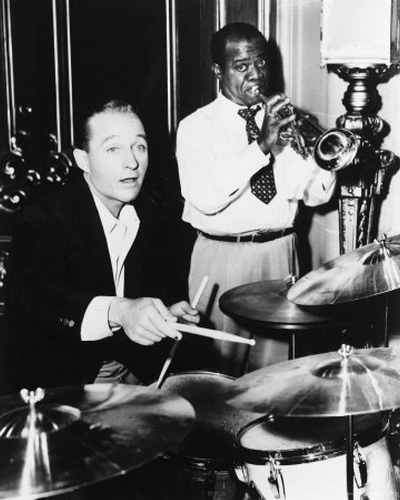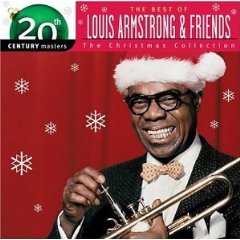Vintage Cool Yule
By David McGee
THE BEST OF LOUIS ARMSTRONG & FRIENDS: THE CHRISTMAS COLLECTION
Hip-O
1997; reissued, 2003
CHRISTMAS THROUGH THE YEARS
LOUIS ARMSTRONG
Laserlight
1969; reissued, 1997
THE BEST OF BING CROSBY: THE CHRISTMAS COLLECTION—20TH CENTURY MASTERS
Bing Crosby
MCA, 2003Bing Crosby has been an indelible part of the Christmas experience since recording the original version of Irving Berlin’s “White Christmas” in 1942, and as the years pass Louis Armstrong rightly pops up frequently on holiday playlists and collections, getting the most out of his meager but impressive holiday testimonials. For aficionados of Christmas music, though, a Yule without Der Bingle or Satchmo would be comparable to finding a lump of coal in the stocking on Christmas morn.
Though several compilations of Armstrong’s holiday recordings exist—always packaged along with offerings from other artists—the must-have, and most complete, among these is The Best of Louis Armstrong & Friends: The Christmas Collection, a 2003 Hip-O reissue of its 1993 CD, Louis Armstrong & Friends: What A Wonderful Christmas. Should have kept the original subtitle, because this one is indeed wonderful, and more. From Louis’s standpoint, it kicks off with his robust, swinging classic from 1955, “Christmas In New Orleans,” with Louis and His All-Stars accompanied by the powerhouse Benny Carter Orchestra. The lyrics Louis chews so deliciously reference his beloved Crescent City (“you’ll see a Dixieland Santa Claus, leading the band/to a good ol’ Creole beat/and golly, what a spirit, and you can only heart it/down on Basin Street…”) and he cuts out on a striking trumpet solo about halfway through to boot before sending it home with a big ending. A similar energy infuses another ’55 track with the Carter Orchestra, “Christmas Night in Harlem,” which is as remarkable for its rich horn chart and strutting trumpet solo as it is for Louis’s jovial reading. From 1952 Louis assays “White Christmas” with warm, deliberate articulation, and gets a splendid assist from the lovely string arrangement executed by Gordon Jenkins and His Orchestra. Also from 1952, Jenkins and Orchestra back Louis with a laid-back, bluesy arrangement perfectly mated to the singer’s folksy, genial delivery, all serving to enhance the song’s dream mood and close the album on a soothing note. With the Commanders in tow in 1953, Armstrong leads the way through two frisky novelty numbers, the first being “Cool Yule” (“so dig,” Louis sings, “Santa comes on big!”), which was penned by Steve “I Wrote 2,000 Songs” Allen, who apparently objected to some liberties taken with his arrangement by producer Tutti Camarata, who had more music in his pinky than the hapless Allen had in his entire, mostly forgettable oeuvre. Allen’s appropriate response should have been, “Yes, Mr. Camarata, whatever you say, sir. I’ll be happy to cash the royalty check.” The other tune from this session with Camarata and the Commanders is “’Zat You, Santa Claus?,” an occasion for Louis to add his own distinctive comedic flair to the querying lyrics directed at an elusive Saint Nick, who seems to be striking some fear in Satchmo’s heart.
As for the Friends of Louis, let’s say all perform commendably, even memorably, starting with Eartha Kitt’s immortal, sensuous come-on from 1953, “Santa Baby,” with that kitten-ish, cooing vocal, all cool heat on a cool Yule, all the better for her to suggest her romantic investment should yield material dividends (“Santa baby, just slip a sable under the tree, for me…a ’54 convertible, light blue, I’ll wait up for you, dear, so hurry down the chimney tonight…”) in what is one of American music’s most spectacular double-entendre performances. Eartha is a hard act to follow, but Dinah Washington gets the job done by going in exactly the opposite direction, towards ennobling reverence, in treating “Silent Night” like the church hymn it was originally intended to be, complete with a supporting choir humming behind and shadowing her dignified reading. Ditto for Peggy Lee, recording “It’s Christmas Time Again” in 1953, with a sweet, soothing, innocent disposition made all the more engaging by a delicate music box chimes solo. The other outstanding female vocalist to make her mark here is Lena Horne, with a typically jazzy rendition of “Santa Claus Is Coming To Town,” her trademark sultriness and asymmetrical phrasing supported by an orchestra skilled in responding to the lady now cutting loose, now pulling back, now roaming at will.
On the male side, Armstrong has plenty of competition here. Louis Jordan, from a 1951 session with his big band, offers up a beautiful, spiritually oriented R&B ballad, “May Everyday Be Christmas,” singing it in a mellow baritone he didn’t often employ in his usual, raucous guise, with the arrangement further spiced by expressive organ chording courtesy Jordan’s arranger, Wild Bill Davis. More overtly bluesy and horn-driven is Lionel Hampton’s alternately simmering and roiling treatment of the classic “Merry Christmas, Baby,” featuring vocalist Sonny Parker in a fine, high tenor pleading mode, a tasty vibes solo by Mr. Hampton himself about halfway through, and a signature trilling piano lick throughout the R&B ballad. Not least of all, certainly, is Duke Ellington, from 1962, giving “Jingle Bells” an “A-Train”-like propulsion in a Mercer Ellington arrangement rich in textural contrasts between horns and woodwinds as the song trundles to a soaring climax.
The odd, sonically challenged Laserlight entry, Christmas Through the Years, also kicks off with “Christmas Time In New Orleans” and “’Zat You, Santa Claus?,” both so poorly mixed that Louis sounds like he’s singing in a cave—and a different cave than the orchestra is playing in, at that. That this tacky mix was actually released is nigh on to unbelievable—it’s a disservice to a great American artist and to consumers alike. Hang on, it gets weirder. Only four of the 10 songs here are actual Christmas songs (and that’s excluding “Baby, It’s Cold Outside,” which shows up on Christmas albums anyway, because it’s set in winter); aside from the abovementioned pair, one other is “Santa Claus Blues,” an instrumental that the liner notes don’t tell you—because there are no liner notes—was recorded in 1924 by the Red Onion Jazz Babies with Louis on cornet, Lil Armstrong on piano, Buddy Christian on a mean banjo, Buster Bailey wailing on clarinet and Aaron Thompson on trombone. A year later Louis would record the same song with the Clarence Williams Blue Five, featuring Sidney Bechet on soprano sax and vocalist Eva Taylor singing the lyrics absent from this instrumental version. The latter version, and some wonderful holiday material recorded in the ‘20s and ‘30s (by the likes of Louis, Fats Waller, Benny Goodman, Duke Ellington, Victoria Spivey, 20-year-old Ella Fitzgerald, Johnny Otis, Count Basie, Louis Prima and Lionel Hampton) is available on an out of print album, Santa Claus Blues, available from Amazon dealers. Otherwise the tunes here include live performances (undated and otherwise unidentified, of course) of “Hello, Dolly,” “Blue Moon,” a duet with Bing Crosby on “Gone Fishin’” (from Bing’s television show, clearly), “A Kiss to Build a Dream On,” and “What a Wonderful World”—not bad, any of them, but Christmas through the years? Hardly. There is one overriding reason to own this disc: it includes the only CD release of Louis’s 1971 promotional recording for the Lorillard Tobacco Co. (released as single CP-1001 by Continental Productions; it was also Armstrong's final recording—he died two weeks later) of his reading of Clement Moore’s poem, “The Night Before Christmas,” a simply superb recitation that mostly sticks to the text, but as only Louis could deliver it, with a few improvisational flurries along the way to enhance the story arc, you might say—truly, a landmark performance. (Listen to the entire reading on our Contents page in this issue.)
Bing Crosby and Marjorie Reynolds in the 1942 film, Holiday Inn, in which Bing introduced Irving Berlin’s ‘White Christmas.’ Reynolds’s singing voice was dubbed by Martha Mears.As for Der Bingle, what to say but that he elevated the Christmas song and carol to new aesthetic heights with his smash hit original recording of Irving Berlin’s “White Christmas” in 1942. Reportedly the biggest-selling artist/title pairing in music business history, “White Christmas” brought out the best in Crosby’s warm, crooning style—the soulful introspection of his reading, the wistful shadowing amidst his hopeful longing, even the clear, evocative whistling he did in the original recording. Until recently the 1942 version had been almost impossible to find, supplanted as it was by Bing’s 1947 re-recording, the most often heard version of the song (the story is he had to record it again because the original master was worn out from so many copies being pressed). It was finally reissued on CD in 1997 in a first-rate collection titled Bing’s Gold Records, a worthy single-disc overview of the artist’s early Decca years, most of it having nothing to do with Christmas at all, but all of it Grade A quality. The original is now available in the context of a wealth of superb holiday recordings from the Crosby files over the years gathered together on CA’s essential 18-track The Christmas Collection. Also on board is his mammoth hit recording of “Silent Night” (Bing recorded this one five times for Decca between 1935 and 1954), and a variety of flavors ranging from the sacred (“Adeste Fideles,” “The First Noel”), to the novelty (“Rudolph the Red-Nosed Reindeer,” “Santa Claus Is Coming To Town,” a delightfully syncopated and Dixieland-tinged “Jingle Bells”), to classic pop evergreens (“The Christmas Song,” “Sleigh Ride,” “I Heard the Bells On Christmas Day”). Suffice it to say that Bing Crosby’s artistry was abundantly blossoming on this seasonal fare, and it’s not too far-fetched to suggest that the all consuming commitment to and intelligence of his earliest Christmas recordings directly inspired Frank Sinatra to emulate Bing’s template and then go one step further by making Christmas songs an indispensable part of his musical narrative through the years. Crosby and Sinatra scholars will always debate who did what better, but when it comes to this time of year, the music wins big, and so do the fans.
Founder/Publisher/Editor: David McGee
Contributing Editors: Billy Altman, Laura Fissinger, Christopher Hill, Derk Richardson
Logo Design: John Mendelsohn (www.johnmendelsohn.com)
Website Design: Kieran McGee (www.kieranmcgee.com)
Staff Photographers: Audrey Harrod (Louisville, KY; www.flickr.com/audreyharrod), Alicia Zappier (New York)
E-mail: thebluegrassspecial@gmail.com
Mailing Address: David McGee, 201 W. 85 St.—5B, New York, NY 10024



